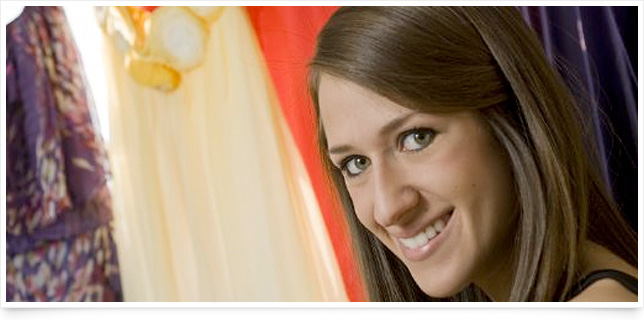One Fashionable Summer
An internship at Allure magazine taught Skylar Shapiro (CGS’10) the ins and outs of fashion publishing.
Before starting her summer internship, CGS student Skylar Shapiro fretted over what to wear to the office. These weren’t simply first-day-on-the-job jitters: Shapiro’s internship was with the fashion department at Allure magazine, and—after watching Meryl Streep ladling scorn in The Devil Wears Prada—she feared the staff there might judge her as much on her wardrobe as on her work ethic.
The pressure to assemble perfect outfits continued throughout the internship, Shapiro says, “but I definitely gained experience and felt more confident as the summer went on—I also acquired a lot of new clothes.”
While Allure’s editors dressed for days spent in air-conditioned offices, Shapiro faced the added challenge of combining fashion with functionality. One rainy Tuesday, for example, she donned a white skirt, only to find herself sitting on the not-so-clean floor sorting clothing samples. Weeks later she arrived at work in chic high heels, and was then assigned to run errands that had her trudging all over Manhattan—an experience that confirmed the adage “Beauty is pain.”

Records, errands, and TV appearances
Shapiro, who has long been interested in art and fashion, landed the coveted Allure internship at the end of her freshman year through her own initiative and a reference from a Delta Gamma sorority sister. Her primary assignment during her two-and-a-half-month stint at Allure was to keep the magazine’s fashion closet organized.
“Magazines don’t pay for any looks,” Shapiro explains. “They just borrow them and send them back.” The magazines store the “looks” (the designer outfits that appear on their pages) in large rooms known as “closets” until they’re ready to return them to the designers. To guard against being accused of losing or damaging any of these fashion pieces, Shapiro says, the magazines keep meticulous records of everything that enters and leaves their closets, whether it’s a $900 pair of Christian Louboutins or a $10 pair of shoes from Target.
The task of logging in the looks usually falls to interns. “You have these little tiny white boards,” says Shapiro, “and you write the designer’s name, and the address that it came from, and the order number, and the date. And then you take a picture of the outfit with the white board, and then you have all the information and the picture in your computer.” The same process is repeated when the look leaves the closet.
Shapiro occasionally got to leave the closet as well—to pick up clothing orders from designers, or to return looks Allure preferred not to send by mail or courier. On several occasions, her supervisor sent her to sample sales. “I spent the first two hours of my day not working, but shopping!” she wrote on July 29 in the journal she kept throughout her internship. Another day she appeared on Fox’s morning show, Good Day New York, modeling looks from Allure’s July issue. Such days weren’t the norm, however. More typically, journal entries describe nine-hour days of lugging around garment bags, filling out shipping labels, straightening the closet, and logging items in and out.
A learning experience
To earn University credit for her internship, Shapiro designed an independent study course with CGS Dean Linda Wells, who conducts ongoing research on the relationship between work and identity. Wells gave Shapiro several writing tasks—including the daily journal—and assigned readings that deal with the nature and history of work. She also guided Shapiro in being thoughtful about her internship experience.
“Internships don’t always give students a good indication of the work in a particular field because, as interns, they’re working at the most basic level,” says Wells. “So it’s not always good for them to make judgments about a career based just on a freshman-year internship.”
To help interns see beyond their menial chores, she says, she reminds them to pay attention to their work environment, to the tasks that people around them are performing, and to the outcome of those tasks. The act of production is often the most satisfying part of a job, she says, so she encourages students to identify the product a specific industry makes and whether or not they enjoy contributing to that product.
With this advice in mind, Shapiro focused closely on the different work environments she encountered during her internship—and she found it wasn’t the magazine office that interested her the most. “When I had to do errands and go to designers to pick things up,” she says, “it was hard for me to leave. I always wanted to stay there and look around.” She was more interested in fabric and clothing, she realized, than in paper and magazines.
While she loved her summer at Allure—“I was living in the fashion closet; that was really fun!”—Shapiro says her internship and directed study projects showed her that her real interest lies in the fashion industry itself, not in the magazines that promote it. She hopes to find an internship this summer working directly for a fashion design house. If that happens, she’ll know which aspects of the work to pay attention to—and she’ll know just what to wear.
 Playing Hardball A new book from CGS prof and political pundit Tom Whalen chronicles the early dynasty of the Boston Red Sox.
Playing Hardball A new book from CGS prof and political pundit Tom Whalen chronicles the early dynasty of the Boston Red Sox. Going Their Own Way Alumni Peter Ross and Nick Riotto launched a company that connects kids with summer camps. And they did it on their own terms.
Going Their Own Way Alumni Peter Ross and Nick Riotto launched a company that connects kids with summer camps. And they did it on their own terms.